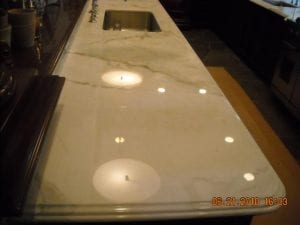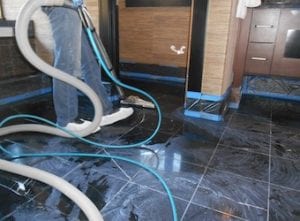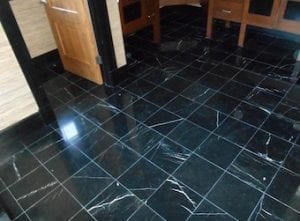Marble Vanity Cleaning and Restoration
Marble Vanity Cleaning and Restoration more often than not, is misunderstood. Those dull “glass-rings” and “water spots” (dull etch marks) baffle many people. And some of them tend to assume and hold incorrect ideas about how marble vanity restoration and marble cleaning is actually done in restoring shine.
A majority of hold the notion that repair of dull spots on marble is achieved by applying some chemical, potion, or lotion when cleaning it. Others believe that all etch marks are some kind of stain and that all marble ought to be shiny.
Well, some explanation is needed because none of the above is true, neither is it entirely false! Let’s now dive into understanding the concept of marble polishing in detail.
It is not surprising the marble polishing topic is surrounded with confusion since there are several different meanings for the term “polish” in the stone industry.
Most often, the terms “polishing”, “polished” or “polish” are used to refer to the type of “finish” that’s done on limestone, natural stone, marble, travertine or granite.
Polished ‘marble’ is the high-gloss, bright type of polish with the deepest color saturation that is commonly used in granite and marble countertops. Because shiny/polished marble is very common, some people tend to assume that all marble ought to be polished and bright.
Different types of Finish
As noted above, however, marble or nearly any natural stone can have several types of finish
A honed marble is satin-smooth, and the colors are muted to some extent. It is often called a matte finish. Other types of marble finishes include: flamed, brushed, tumbled, antiqued, hammered, flamed and more. All these have different looks and are non-reflective. Only polished marble features the shiny, high-gloss surface.
Marble Vanity Cleaning and Restoration is a process with clearly identifying what you have and what kind of conditions they are in. Most marble floors often have honed finishes because they are easier to repair and maintain. And in spite of the fact that colors are more muted with a honed finish, many stone patterns and colors are more appealing with this type of finish.
Polished marble floors end up wearing down with time due to increased foot traffic which creates dull trails on the floor. Also, dirt and dust are much more visible on polished floors.
At times people purchase houses with honed floors and mistakenly conclude that something is not okay wrong with it because it appears dull when compared with the marble that’s found in restaurants, etc. They argue that it needs to be shiny, or polished with the chemical.
It’s a common misconception that in order to have polished floor tile or marble counter tops, one has to apply some type of chemicals to the surface. Well, this is not the case. The shine on marble isn’t something that sits on the marble; it is a composition of the marble.
While there are times when cleaning solutions can be used for polishing countertops, it utilizes a process like that is physical in nature such as wood-sanding to rekindle the shine. The chemicals themselves don’t supply the shine.
Restoring the finish by diamond impregnated pads with various grits of abrasion from course to successively finer grit to remove scratches, etch marks, and blotching areas and some stains. This is a Three to Five step process focusing on the restoration of the hard surface. This process is necessary to remove the water etching marks and make the marble look consistent throughout. All furnishings will be carefully protected before work starts.
After restoring the counters, SteamMaster will buff and seal the surface with two (2) coats impregnating marble protector sealer, which will penetrate into the substrate creating a barrier that is resistant to water, oil, and stains, and will decrease surface absorption, and minimize wear and tear. This protection is not permanent and may need to be reapplied every year.
Also, this particular product is designed to work on marble (limestone or travertine too) that was initially polished to shine. Therefore, it repairs damaged marble floors but isn’t sufficient to make that shine from pure marble to start with.
Marble (travertine and limestone too) is reactive and sensitive to certain kinds of foods, chemicals, and products, which can spoil the floor surfaces leaving dull or lighter-colored etch spot often described as “ghost stain”, “glass-ring”, or “water spot”.
So, if you spill acidic pineapple juice or any of the many acidic drinks and foods on countertops and floors, it is no doubt going to be damaging their surfaces. This corrosive reaction initiated by the chemicals will essentially destroy the clean surface layer that was achieved after polishing the marble using the methods described above. The destruction will end up revealing the dull marble beneath. Likewise, if you make use of the wrong products to clean your marble (too alkaline or too acidic) by using the wrong pH solution you can spoil the shiny appearance over their surfaces making your whole marble floor or countertop dull.
NOTE: The property and its interior finishes are carefully protected when needed to prevent damage before any work begins.
SteamMaster recommends all sink fixtures be removed by the client to allow us to reach all surface areas of the counters to diamond grind. SteamMaster cleans the multitude type hard surfaces. Please call us at 970-827-555 for a FREE Estimate today.



